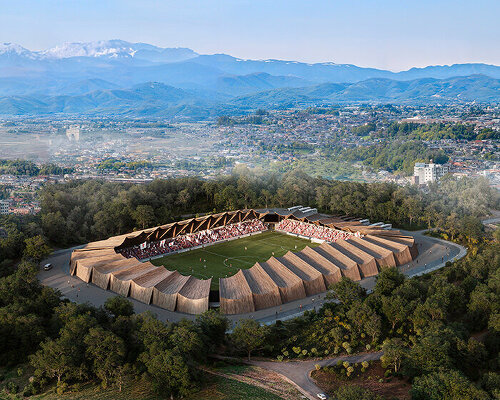vuild unveils mass-Timber Stadium Concept
Fukushima United FC announces plans for a new timber stadium in Fukushima Prefecture, Japan, designed in collaboration with architecture startup VUILD. Developed as a 5,000-seat venue, the project introduces the country’s first circular timber stadium concept, envisioned as a model for sustainable and community-driven architecture.
The proposal positions the stadium as a ‘symbol of recovery,’ as it will occupy a region that continues to carry the memory of a 2011 earthquake and nuclear disaster. Within this context, the project is a forward-looking gesture of resilience. With resilience and circular design embedded into its architecture, the stadium is intended as a lasting expression of the spirit of the area.
a new stadium in Fukushima is designed with a circular timber structure | visualizations © VUILD
Timber Construction and circular Design
With its initial planning of the timber stadium for Fukushima, Japan, VUILD seeks to maintain a human-scale form while accommodating 5,000 seats. Instead of concentrating all seating in a dominant main stand, the design circulates a cross-section equivalent to a two-story house. The team divides the stadium into four volumes, each with its own entrance.
Central to the concept is the use of timber sourced from local forests. Laminated wood will form the structural framework, with components engineered for disassembly and reuse. This approach by the at VUILD reflects a circular model, in which materials are cycled back into use rather than discarded.
The design draws inspiration from Japan’s tradition of Shikinen Sengu, the ritual rebuilding of shrines at regular intervals. Here, that idea translates into three cycles: resources, community, and craftsmanship. The team will organize reforestation programs, woodworking education, and participatory construction to ensure that skills and resources regenerate alongside the stadium itself.
the triangular roofscape echoes the thatched houses of Ōuchi-juku in Fukushima
a roofscape informed by the region’s heritage
To achieve the six-meter spans of the stadium’s structure, the design employs hyperbolic paraboloid shells formed from small cross-section timber members. These shells allow cantilevered roofs in the short direction and long spans across the main axis. Timber members suspended in catenary form are layered above the shell, creating a triangular roof profile.
The roofscape references the steep thatched houses of Ōuchi-juku, an historic post town in Fukushima, creating a visual link to the region’s built heritage. Construction is envisioned as a participatory act: structural elements are designed to be raised collectively, echoing the ceremonial timber-raising rituals of Japanese tradition. This festive method transforms construction into a symbolic act of recovery as well as a technical process.
the roof comprises hyperbolic paraboloid shells with suspended catenary timber members
passive energy strategies
Responding to the basin climate of Fukushima, the design integrates passive energy strategies. A roof form has been devised to provide shade from strong summer sun and shelter from winter winds. Facade geometries are shaped to allow breezes in warmer months and provide insulation in during the winter.
Water and snow management are also integral. Rainfall will be collected, filtered, and reused within the facility, while stored winter snow will help regulate summer cooling. These measures reduce reliance on mechanical systems and support energy circulation rooted in the site’s seasonal rhythms.
Alongside material cycles and climate-responsive design, the stadium incorporates renewable power generation with the aim of achieving self-sufficiency. Energy storage will ensure continuity of supply, advancing the goal of meeting the Living Building Challenge, which is recognized as one of the most rigorous international environmental standards.
all timber is sourced locally and fabricated into units assembled by community members
project info:
name: Fukushima United FC Stadium
architecture: VUILD | @vuild_architects
location: Fukushima, Japan
The post japan’s first circular timber soccer stadium to be built in fukushima appeared first on designboom | architecture & design magazine.

